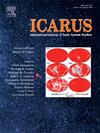基于“嫦娥五号”样本和遥感影像的高保真月球风化模拟研究
IF 3
2区 物理与天体物理
Q2 ASTRONOMY & ASTROPHYSICS
引用次数: 0
摘要
嫦娥五号(CE-5)任务是中国取回月球样本的开创性努力,带回了大约1.7公斤的月球样本。这些CE-5样品为研究月球风化层的性质和帮助了解月球的地质演化提供了有价值的材料。在这项研究中,我们提出了一个框架,用于开发与CE-5着陆点的风化层非常相似的月球风化层模拟物。首先,根据着陆器足垫的撞击深度和月壤特性,确定了CE-5着陆的月壤原位内摩擦角,估计范围为29.2°~ 43.0°。其次,对CE5C0300YJFM002GP和CE5C1000YJFM002GP两个CE-5月球样品进行了扫描电镜、显微计算机断层扫描和立体显微镜分析,研究了颗粒形态和尺寸分布。第三,根据样品的统计数据,通过控制样品的堆积密度和粒度分布,通过干燥、研磨、筛分、混合等过程,研制出一种新型月球风化层模拟物,命名为同济大学- ce5 (TJ-CE5)。随后,进行了一系列测试,以表征TJ-CE5模拟物的特性。测得TJ-CE5的内摩擦角为36.9°,与原位预测值一致。最终,导出的TJ-CE5模拟物在密度、颗粒形态、粒度分布、内摩擦角和化学成分等方面与CE-5月球风化层相当。因此,本研究的框架可以应用于制备其他针对不同着陆点具有不同性质的月球风化模拟物。本研究建立了模拟月球风化层特征的方法,为支持月球探测和建设任务的地面实验提供了材料。本文章由计算机程序翻译,如有差异,请以英文原文为准。
Developing a high-fidelity lunar regolith simulant based on Chang'E-5 samples and remote sensing images
The Chang'E-5 (CE-5) mission, China's pioneering endeavor to retrieve lunar samples, brings back approximately 1.7 kg of Moon samples. These CE-5 samples provide valuable material for investigating the properties of lunar regolith and help to understand the geological evolution of the Moon. In this study, we propose a framework for developing a lunar regolith simulant that closely resembles the regolith at the CE-5 landing site. Firstly, the in-situ internal friction angle of the lunar regolith where CE-5 touched down was determined based on the impact depth of the lander footpad and the lunar regolith properties, yielding an estimated range from 29.2° to 43.0°. Secondly, two CE-5 lunar samples, CE5C0300YJFM002GP and CE5C1000YJFM002GP, were analyzed using scanning electron microscopy, micro-computed tomography, and stereoscopic microscopy to investigate particle morphology and size distribution. Thirdly, according to the statistical data from the samples, a new lunar regolith simulant named Tongji University-CE5 (TJ-CE5) was developed through a process involving drying, grinding, sieving, and blending by controlling the bulk density and size distribution. Subsequently, a series of tests were conducted to characterize the properties of the TJ-CE5 simulant. The internal friction angle of TJ-CE5 was measured as 36.9°, which is consistent with the predicted in-situ value. Ultimately, the derived TJ-CE5 simulant is equivalent to the CE-5 lunar regolith in terms of density, particle morphology, particle size distribution, internal friction angle, and chemical composition. Therefore, the framework of this study can be applied to the preparation of other lunar regolith simulants with different properties specific to various landing sites. This research established a methodology for developing a simulant that replicates the characteristics of lunar regolith and provided material for ground experiments supporting lunar exploration and construction missions.
求助全文
通过发布文献求助,成功后即可免费获取论文全文。
去求助
来源期刊

Icarus
地学天文-天文与天体物理
CiteScore
6.30
自引率
18.80%
发文量
356
审稿时长
2-4 weeks
期刊介绍:
Icarus is devoted to the publication of original contributions in the field of Solar System studies. Manuscripts reporting the results of new research - observational, experimental, or theoretical - concerning the astronomy, geology, meteorology, physics, chemistry, biology, and other scientific aspects of our Solar System or extrasolar systems are welcome. The journal generally does not publish papers devoted exclusively to the Sun, the Earth, celestial mechanics, meteoritics, or astrophysics. Icarus does not publish papers that provide "improved" versions of Bode''s law, or other numerical relations, without a sound physical basis. Icarus does not publish meeting announcements or general notices. Reviews, historical papers, and manuscripts describing spacecraft instrumentation may be considered, but only with prior approval of the editor. An entire issue of the journal is occasionally devoted to a single subject, usually arising from a conference on the same topic. The language of publication is English. American or British usage is accepted, but not a mixture of these.
 求助内容:
求助内容: 应助结果提醒方式:
应助结果提醒方式:


